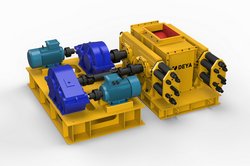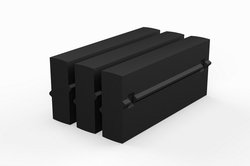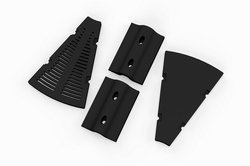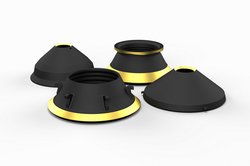Application of High Pressure Grinding Rolls in Nonferrous Beneficiation Plant
1. Introduction
Looking at the global mining development situation, the economic and efficient development and utilization of all kinds of poor, miscellaneous and fine mineral resources is the general trend.
Expanding the production scale and the use of energy-saving equipment to effectively reduce the processing of poor, miscellaneous, fine mineral resources unit beneficiation costs, has become one of the industry's development direction.
In the production process of mineral processing, the ore crushing, grinding process with high investment, energy consumption, it accounts for 40% ~ 70% of the total energy consumption of mineral processing, and some even up to 80%, thus in mineral processing industry, the principle of "more crushing and less grinding" is always recommended, it greatly reduces the production cost.
Since its introduction in the 1980s, high pressure grinding rolls has been rapidly applied in cement industry and mineral processing industry.
2. Working principle
The high pressure grinding rolls is mainly composed of a pair of mutually rotating extrusion rollers, transmission system, lubrication system and control system.
The main motor is connected to the rollers mounted on the frame through universal coupling and reducer.
When rotating, the roller that cannot slide parallel is called the fixed roller, and the one that can slide slightly on the frame slide is called the moving roller. The hydraulic system provides great pressure to the movable roller in order to produce sufficient pulverizing effect on the material.
Typical structures of high pressure grinding rolls as follows
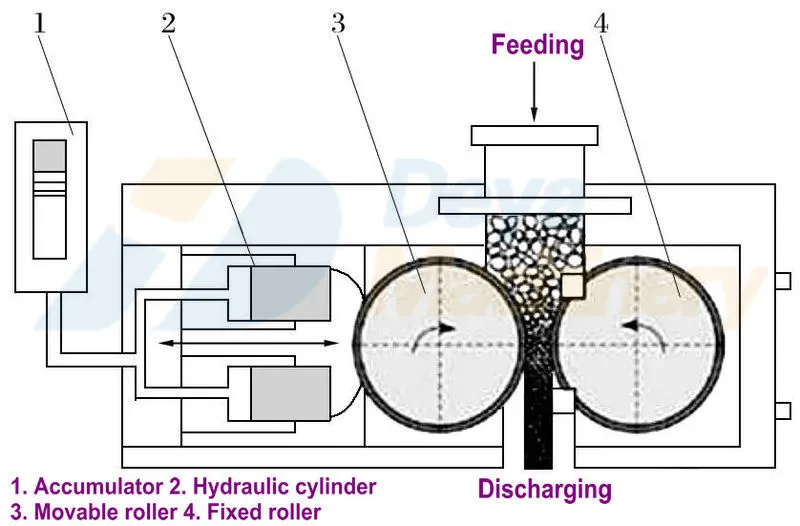
High pressure grinding rolls adopts laminar crushing theory. Laminated crushing theory refers to, a large number of ore particles by the narrow space constraints and gathered together, in the limited space and a strong external force, the gap between the ore particles is getting smaller and smaller, until the particles began to transfer stress to each other.
When the pressure reaches and exceeds the compressive strength of the ore particles, the ore begins to be crushed in large quantities.
In order to ensure the feeding pressure, it must be ensured that the feeding part of the high pressure grinding rolls is well sealed with the end face of the rolls, and there is a certain height of the material level in the feeding device, this material column should be more than 3 meters in order to form a sufficient feeding pressure.
Only a small portion of the ores are in direct contact with the roll surface, and the majority of ore crushing is realized through the mutual extrusion of the materials. Instantaneous crushing also allows the material to pass through the high pressure grinding rolls quickly, so that the process capacity of the high pressure grinding rolls can be greatly increased.
3. Applications in benefication plant
3.1 Back ground of the benefication plant
This plant is located in Henan province, China, it has been in operation for decades.
Original crushing parts adopt typical three-stage and one close circuit process. Primary crushing stage is by gyratory crusher, crushed size maximum 280mm. Crushed ores are sent to the benefication plant for secondary crushing and tertiary crushing, which are by hydraulic cone crushers.
Ores from secondary crushing will be sent to a double layer vibrating screen, mesh size 25mm and 12mm, over mesh size are sent to tertiary crushing, while under mesh size 12mm are sent to the overflow ball mills. Crushing and grinding process diagram as follows
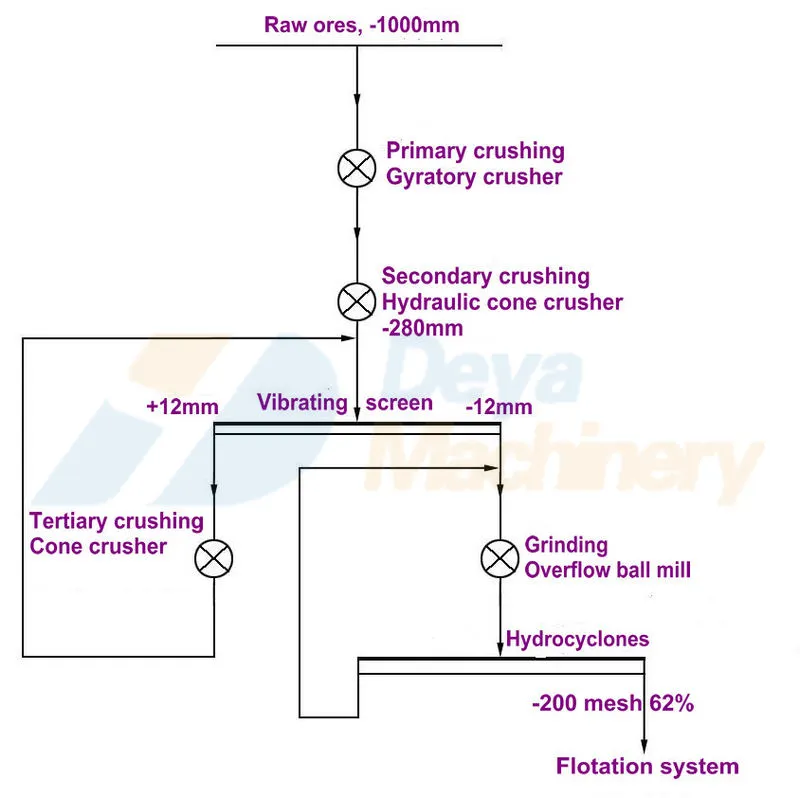
Before renovation, the processing plant processed about 14 400 t of raw ore per day, the processing capacity was formed in 2014, of which the crushing system worked 18 hours per day, grinding and flotation system worked 24 hours per day.
-1000 mm ore from the open pit was crushed in three stages and one closed circuit, and the particle size of the ore entering the ball mill was -12 mm.
After one stage of grinding to obtain the slurry with a particle size of -200 mesh accounting for 62% of the total, and then the slurry was adjusted and dosed to enter the flotation operation.
Size distribution as follows
| Size/mm | production rate | under mesh total % | |
| Part | grand total | ||
| -12.000 +9.000 | 11.06 | 11.06 | 100.00 |
| -9.000 +5.000 | 34.70 | 45.77 | 88.94 |
| -5.000 +2.000 | 21.33 | 67.10 | 54.23 |
| -2.000 +0.180 | 20.65 | 87.75 | 32.90 |
| -0.180 +0.074 | 6.61 | 94.35 | 12.25 |
| -0.074 | 5.65 | 100.00 | 5.65 |
In the continuous downturn of the mining industry situation, most of the domestic non-ferrous metal ore dressing plant production and operation is difficult, facing low capacity, high cost, poor efficiency and many other problems.
The energy saving and production increase transformation of the beneficiation plant, reduce the cost of ton of ore separation, improve the economic efficiency of the beneficiation enterprise has become the urgent needs of non-ferrous metal mining enterprises.
Grinding stage costs account for a large proportion of the cost of mineral processing, the use of energy efficient equipment, increase ultra-fine crushing operations, improve the crushing ratio, reduce the ball mill feed size, not only in line with the mining industry has been advocating the principle of "more crushing and less grinding", but also reduce the cost of beneficiation, improve the efficiency, it is the best choice.
3.2 Test by high pressure grinding rolls
The test samples were provided by the ore dressing plant, and 100% of the samples were smaller than 16 mm and 85% were smaller than 9.5 mm.
The equipment used for the test was GM42-10 high pressure grinding rolls, and 8 parallel tests were conducted under the conditions of roller linear speed of 0.5 m/s and specific pressure of squeezing rollers of 4.05 N/mm2 with the closed-circuit crushing process with a sieve size of 6 mm.
The power consumption and cyclic loads of the high pressure grinding rolls are listed as follows
| Test number | Unit power consumption | cyclic load |
| kW per hour per ton | % | |
| 1 | 1.26 | 16.96 |
| 2 | 1.31 | 21.36 |
| 3 | 1.34 | 21.45 |
| 4 | 1.30 | 19.95 |
| 5 | 1.47 | 20.54 |
| 6 | 1.51 | 21.65 |
| 7 | 1.44 | 22.41 |
| 8 | 1.44 | 21.15 |
| On average | 1.38 | 20.68 |
Analysis of product particle size obtained from closed circuit test of high pressure grinding rolls
| Size/mm | production rate | under mesh total % | |
| Part | grand total | ||
| -6.000 +5.000 | 6.61 | 6.61 | 100.00 |
| -5.000 +3.000 | 17.74 | 24.35 | 93.39 |
| -3.000 +2.360 | 4.32 | 28.67 | 75.65 |
| -2.360 +1.700 | 7.41 | 36.08 | 71.33 |
| -1.700 +1.180 | 8.09 | 44.17 | 63.92 |
| -1.180 +0.850 | 5.88 | 50.06 | 55.83 |
| -0.850 +0.600 | 5.63 | 55.69 | 49.94 |
| -0.600 +0.425 | 5.19 | 60.88 | 44.31 |
| -0.425 +0.300 | 5.29 | 66.17 | 39.12 |
| -0.300 +0.200 | 4.90 | 71.07 | 33.83 |
| -0.200 +0.125 | 3.63 | 74.7 | 28.93 |
| -0.125 +0.106 | 4.47 | 79.16 | 25.30 |
| -0.106 +0.074 | 4.28 | 83.45 | 20.84 |
| -0.074 | 16.55 | 100.00 | 16.55 |
As can be seen from the test results, the high pressure grinding rolls fine crushing energy consumption is low, the closed-circuit product size is very fine, the product of the P80 = 3.5 mm, much lower than the ball mill feed particle size, finished product fines content about 30%, high pressure grinding rolls ultra-fine crushing effect is remarkable.
3.3 Application and renovation by high pressure grinding rolls
After designing and selecting, 2 sets of GM160-140 high pressure grinding rolls were finally determined to operate in parallel as ultra-fine crushing equipment, in order to improve the crushing ratio of the crushing system, reduce the particle size of the material to be ground, and save the cost of ore process plant.
The main parameters of the GM160-140 high pressure grinding rolls are listed as follows
| Equipment model | GM160-140 |
| Motor | 2x1250 kW |
| Roller diameter | 1600mm |
| Roller width | 1400mm |
| Cyclic load | 100% |
| Maximum pass capacity | 1200 tons per hour |
| Roller design life | 8000 hours |
According to the design program, after the renovation, the medium crushing products are screened by vibrating screen, +25 mm particles are fed into the original fine crushing cone crusher, and the -25 mm particles are fed into the new high pressure grinding rolls.
After the trial production, it was found that the processing capacity of the medium crushing cone crusher was insufficient and the load was large, while the processing capacity of the high pressure grinding rolls had a certain degree of affluence.
After many analyses and demonstrations, the screen size was changed to 35 mm x 40 mm, with +35 mm going to the fine cone crusher and -35 mm going to the high pressure grinding rolls, so that the capacity of the crushing system can be coordinated and matched.
The modified crushing and grinding process is shown as follows
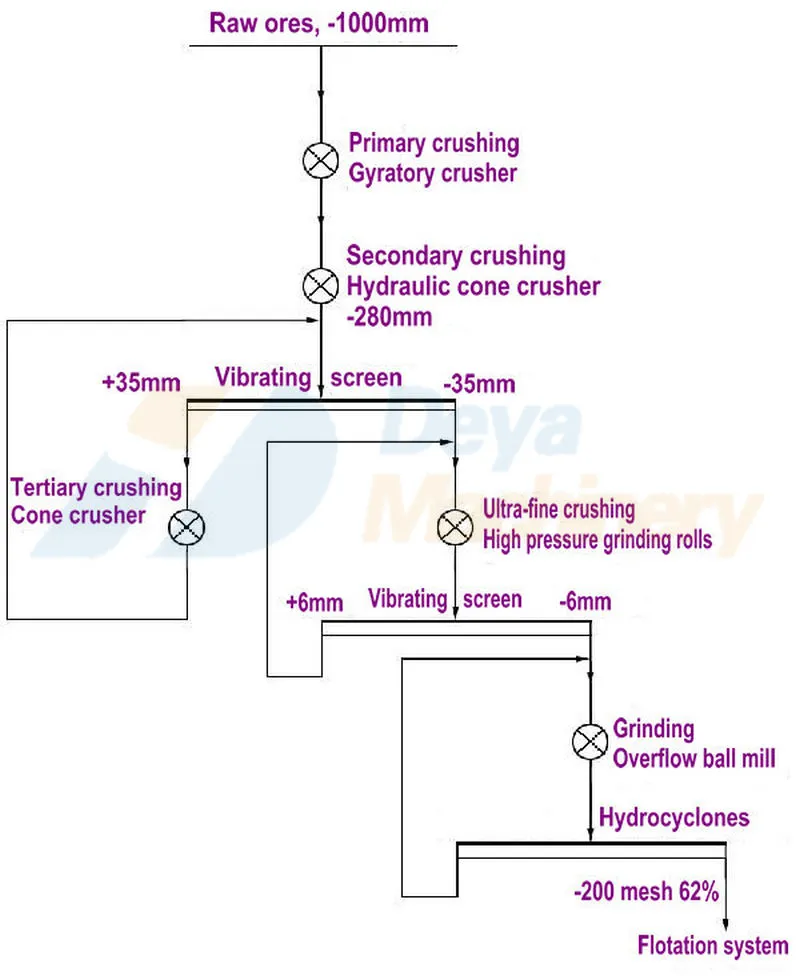
The renovation project started construction at the end of 2016, was completed and tested in July 2017, and formally put into production use in August.
After practical inspection, the carbide roller surface of the high pressure grinding rolls forms a good material mat, which extends the life of the roller surface.

By end of 2018, the plant has been in continuous production for 17 months after the renovation, and after the expansion of its flotation system, the daily processing capacity of the plant has stabilized at about 24,000 t, which is about 67% higher than the previous production before the renovation.
The particle size distribution of the ore entering the mill after the renovation is listed as follows
| Size/mm | production rate % | under mesh total % | |
| Part | grand total | ||
| -6.000 +5.000 | 11.10 | 11.10 | 100.00 |
| -5.000 +2.000 | 22.86 | 33.96 | 88.90 |
| -2.000 +0.180 | 35.30 | 69.26 | 66.04 |
| -0.180 +0.074 | 16.58 | 85.84 | 30.74 |
| -0.074 | 14.16 | 100.00 | 14.16 |
In the strip production, the circulating load of the high pressure grinding roll is about 100%, and the pressure of the hydraulic cylinder of the dynamic roller is stabilized at about 10 MPa.
The true density of the ore is 3.18 g/cm3, and the bulk density of the cake is 2.88 g/cm3, which is 0.9 times of the true density of the ore. The material cake formed by roller pressing is easy to be dispersed after conveyor belt transfer and natural fall, it has no effect on the screening efficiency.
Sampling and analysis in October 2018, in accordance with the standard procedure of Bond ball milling power index test found that the power index of the ore without high pressure grinding rolls was 13.78 kW-h/t, and the power index of the ore treated with high pressure grinding rolls was 11.84 kW-h/t, which was a decrease of 14.08%.
It can be seen that the high pressure grinding rolls has an obvious reduction effect on the downstream grinding energy consumption.
At the same time, after adding the high pressure grinding rolls for ultra-fine crushing, the service life of the cylinder liner of φ4.8 m×7.0 m ball mill in this beneficiation plant has been increased from 11 months to 14 months, and the power consumption of grinding and floating system has been reduced by 5.5 kW-h/t, and the cumulative power consumption of the whole beneficiation plant has been reduced by 3.2 kW-h/t, and the overall unit consumption of raw ore dressing has been reduced by 5.7 yuan/t, which has significantly improved the benefit of the beneficiation plant. The efficiency of the beneficiation plant has been greatly improved.
4. Conclusion
This beneficiation plant is the first non-ferrous mine project in China that applies high pressure grinding rolls to transform the three-stage and one closed-circuit crushing system.
By adding high pressure grinding rolls as ultra-fine crushing operation on the basis of three-stage and one closed-circuit, the particle size of the ore fed into the mill is reduced from -12 mm to -6 mm, and the Bond Ball Grinding Efficiency Index of the material fed into the mill is lowered to a certain extent, the wearability of the ore is improved, and the unit consumption of liner plate and steel ball is lowered.
At present, the high pressure grinding rolls has become a hot spot of process innovation in mineral processing plant, more and more mining enterprises choose to use the high pressure grinding rolls for fine crushing and ultra-fine crushing.
Domestic high pressure grinding rolls has won the market recognition with its high cost performance and good after-sales service.
It promotes the green and efficient development of the traditional non-ferrous metal beneficiation plant and has a bright future.
Contact us for more information about the high pressure grinding rolls.

